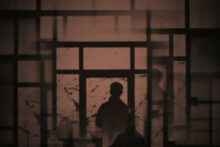Oren Ambarchi by Trianos Pakioufakis
Oren Ambarchi has always been interested in the mystery of making music, in decoding how each sound he hears gets made. The Australian artist has told stories about his early obsession with the art form, spinning Led Zeppelin records so much they would wear out as a kid, of his middle school experimentations with his very own cassette collages, of teaching himself ways to play guitar after seeing and becoming enthralled with Keiji Haino.
That audacious musical attitude, and desire to discover, has extended throughout his lifetime, from his teen years finding free jazz to his young adulthood hopping from show to show across downtown New York. It led him to become an avid collaborator, working with the likes of Jim O’Rourke, Alvin Lucier, SUNN O))), Loren Connors – the list goes on and on – and an unconventional soloist and head of eclectic label Black Truffle. But the one thing that ties all of Ambarchi’s projects together is his desire to travel the untraveled, to make music that feels like an everlasting adventure.
This exploratory feeling colours his latest album, Shebang, which highlights delicate patterns, looping and interlocking to create entangled paths. Alongside Ambarchi on the album is a characteristically star-studded ensemble of collaborators: Chris Abrahams on piano, Johan Berthling on bass, BJ Cole on pedal steel, Sam Dunscombe on bass clarinet, Jim O’Rourke on synthesizers, Julia Reidy on twelve-string guitar and Joe Talia on drums. Each of their lines seamlessly weave together, foregrounding an ever-present, ever-changing groove that often feels quiet yet beaming. It’s similar to Ambarchi’s previous 2022 album, Ghosted, which also played with repeating melodies but embraced the spontaneity of live performance, and draws from styles established on his previous albums Quixotism and Hubris, piecing parts together like a puzzle and watching the gradual transformation of sound over time. But like much of Ambarchi’s shapeshifting work, there’s not much to pin it down – instead, it’s a quest that uncovers treasures along the way.
The inspiration for Shebang came when Ambarchi first heard guitarist Julia Reidy perform on a twelve-string acoustic guitar in Melbourne. As he listened to her looping, plucked melodies, he began to imagine other parts around it, like a ride cymbal; the two would later meet up and record a clip together that would be forgotten about for a while. On Shebang, her playing appears in shimmers, surrounded by ticking percussion, upbeat piano and a swath of other sounds that Ambarchi spliced together from each collaborator. The album wasn’t made with each person in the same room – instead, each artist recorded something in their own voice and Ambarchi connected the dots. There’s something enticing about the ways Shebang offers each artist their own space yet still maintains cohesiveness, finding the connections between each line to form a quilt made of each artist’s individuality.
Both Ambarchi’s 2022 albums, Shebang and Ghosted, are marked by careful pace and precision. Musically, both of these albums exemplify the richness of letting one, simple melody branch out, seeing how repetition and layering can subtly, even imperceptibly, alter the trajectory of a phrase. On Shebang, these shifts come through in radiant waves. The feeling of the album is often optimistic – flickering, vibrant hues emanate from the ever-growing patterns that Ambarchi and his collaborators establish together. At times, its exuberance feels like a celebration, but it never gets too loud or boisterous. Instead, Ambarchi draws from the power of potential energy, letting sound build and churn in quietude, never quite rupturing.
Much like the individual layers of Shebang, which unite with ease, the album as a whole is all about fluid motion and finding balance between its elements. Each track emerges from the last nearly undetectably, so much so that the record doesn’t feel like four separate tracks, other than the fact that each movement offers a different feeling to get lost in – the first, a foot-tapping groove; the second, a sparse tremor; the third, a full, rich sound; and the fourth, a swirling trance. From the first seconds, the album also introduces rhythms that become its backbone, creating a forward-moving spirit that travels between moments of glimmering steadiness and cascades of truncated piano and guitar melodies and syncopated rhythms. There’s a push and pull between urgency and being laid back throughout – while the opening groove serves as a chugging spine of the music, the sound also feels bright and relaxed, like a hazy summer afternoon.
And while much of this music is an evolution from and of itself – the opening groove, in a variety of different forms, from sparse cymbal taps all the way to optimistic sonic waterfalls – the final movement of the album proves to be the greatest exploration. Here, that energy that’s been bubbling finally releases in flutters, as percussion becomes a little less bound and sounds begin to wobble. It starts to become untethered, but not enough for all the threads to unravel. Rather, Ambarchi begins to play with those tightly-packed rhythms, pushing them to their boundaries, seeing how far they can go without coming undone. By the final moments, the track’s organised chaos once again appears, letting oscillating piano and electric twinkles form a hazy cloud that abruptly vanishes into the ether.
And while these mechanics form the sturdy foundation of the music, they aren’t necessarily the most important factor when thinking about the album’s larger picture. Shebang often feels like one mass that glides from one atmosphere to another without a hitch, so much so that you may not even register the changes until they’ve passed. But look deeper into any one moment and you’ll find a bottomless pit of possibility. At the heart of this music is a quest, a journey to peel back every layer and see what’s left behind.




